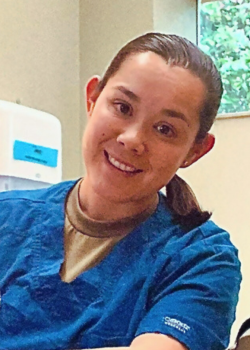As dentistry evolves, the need for qualified dental assistants grows

By Janée Tamayo, CDA, CPFDA, B.S., MSgt, USAF; DANB Board Chair
As a Dental Flight Chief in the U.S. Air Force, I am accustomed to adapting to meet fast-paced challenges, and I take my role of ensuring our service members’ dental health very seriously. I’ve been a dental assistant for over 10 years, and it’s been a career that has continuously challenged and engaged me. Not only is helping patients incredibly rewarding, but dentistry continues to evolve, and that makes dental assisting an exciting field. Innovations in materials, technologies, and techniques are all impacting dentistry, and dental organizations and teams must continue to keep up.
Earlier this month, the American Dental Association (ADA) Council on Scientific Affairs released updated recommendations on radiation safety. One of the changes that made headlines was that the ADA no longer recommends using lead abdominal aprons or thyroid collars on patients when conducting dental X-rays.
What does this mean for dental practices and specifically for dental assistants who are often the ones taking dental radiographs?
Here are 4 things to consider.
1. Local, state, and federal laws take precedence.
Although the ADA recommendations are important to know and understand, dental practices and practitioners should continue to follow local, state, and federal laws. Some states still require using lead aprons, so practices in those states should continue to use them.
2. Dental assistants need to be knowledgeable.
In my dental assisting career, I’ve fielded many questions from patients about the purpose, risks, and procedures associated with dental X-rays. In light of changing guidance, patients may have questions about whether or not a lead apron is required. Or they may have apprehension or anxiety about having dental X-rays taken. Since dental assistants are typically the ones taking X-rays, they must be properly informed to answer patient questions or reassure patients.
Additionally, dental assistants need to have the knowledge and skills to take X-rays correctly the first time — this benefits the patient by preventing exposure to additional unnecessary radiation, and it supports the practice’s overall efficiency and productivity. Further, dental assistants must be well-versed in radiation safety to ensure their own protection and the protection of their team, as they are taking dental radiographs on multiple patients every day.
3. DANB’s RHS exam, which measures radiation safety knowledge, is regularly updated.
The ADA’s recommendations state that, “Personnel performing radiography-based dental and maxillofacial imaging shall have the qualifications, education, training, and licensure as required by relevant federal, state, and local regulations.” The Radiation Health and Safety (RHS) exam is recognized or required by 23 states and the District of Columbia to perform radiography procedures. Additionally, DANB’s Certified Dental Assistant (CDA) certification, of which the RHS exam is a component, meets state radiography requirements in an additional 8 states.
All DANB exams, including the RHS exam, are reviewed and updated regularly by subject matter experts. The exams are based on psychometrically valid task and knowledge surveys of practicing dental assistants and dentists. These surveys identify how often tasks are performed and how critical competent performance of those tasks is to the health and safety of the public and dental workers themselves.
DANB’s RHS exam was updated in 2022, and at that time DANB removed content related to personal monitoring devices and conventional/film-based radiography. In 2023, the RHS exam was updated to ensure all questions used plain language, and in 2024, DANB introduced the RHS exam in Spanish.
DANB’s RHS exam contains some questions (less than 3%) on lead aprons and thyroid collars since they are still used on patients in many dental practices and their use is still required by law in some states. Interestingly, DANB’s last Job Task Analysis Survey, launched in January of this year, showed that over 85% of dental assistants stated they place a lead apron on a patient at least once per day. As the prevalence of the use of lead aprons goes down with time, so too will the number of questions on the RHS exam.
4. The need for qualified dental assistants is more important than ever.
It is important to recognize that dental assisting is a highly accessible career that offers many pathways into the profession, with varying standards of education and training from state to state. This means that dental practices are often in the best position to support their dental assistants’ learning and development.
Dental assistants who have passed valid exams or hold certification have demonstrated they have retained the necessary knowledge to perform key duties, such as taking X-rays, safely and effectively. Additionally, dental assistants who are DANB certified earn continuing education every year, so they are on top of the latest science, guidance, and best practices.
Oral health is a crucial component of overall wellness, and with ongoing advancements in dentistry, having qualified personnel is critical. Ensuring that dental assistants are well-educated and well-trained is more important than ever so they can fully support their patients and practices now and in the future.

Janée Tamayo, CDA, CPFDA, B.S., MSgt, USAF, is the Chair of DANB’s Board of Directors. She is the Dental Flight Chief at the U.S. Air Force’s 43rd Medical Squadron.
Opinions expressed in the article are those of the author alone. Information is presented for reference only. No endorsement by the Department of Defense or U.S. Air Force is intended or implied.

